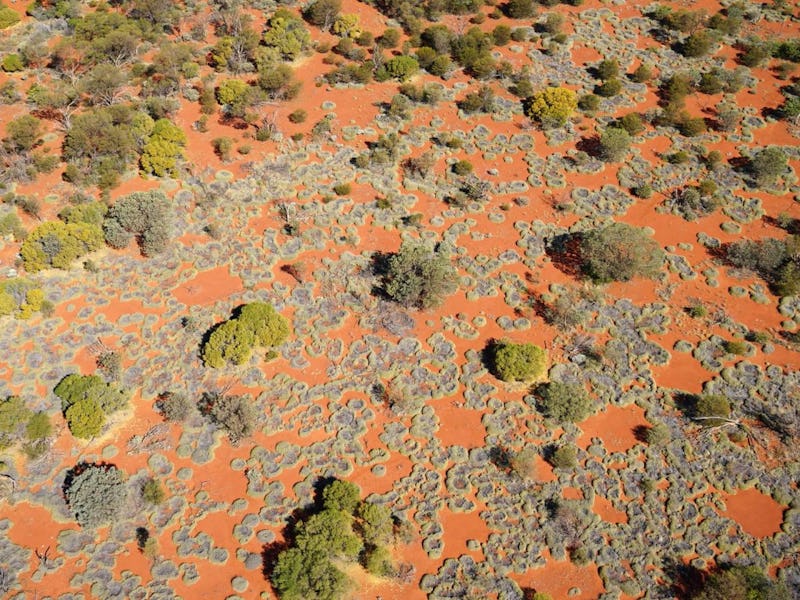Scientists solve fairy circle mystery with math
Fairy circles are ethereal, but there's hard science behind these fantastical formations.

There is a magic about a naturally forming circle. These so called "fairy circles" are a source of wonder and fantasy, a seemingly mystical moment in nature when the randomness of a grassy plain is interrupted by geometric patterns in the grass.
Fairy circles are commonly found in arid places like Australia and Namibia in Africa. (They're different from the circular mushroom formation, known by the same name or as fairy rings.)
But these otherworldly phenomena can in fact be explained by mathematical reasoning, a new study explains.
Grasses that create fairy circles do so to adapt dry conditions and make them more favorable for life to thrive, researchers report in a new study. In this way, the vegetation is able to engineer its own ecosystem to maximize its potential for survival.
Using drone-mounted cameras, spatial statistics, and computer mapping, the researchers behind the new study scoured the Australian outback for evidence of this phenomenon in action. They tracked whether the plants, called Triodia grasses, were thriving by assigning them a "vitality status," ranging from high to low.
What they found suggests a curious mathematical underpinning to how these circles arise.
The findings were published Tuesday in the Journal of Ecology.
Testing Turing's reaction-diffusion — The results confirm a model originally developed by mathematician and computer scientist Alan Turing: the Turing pattern.
Drone footage of fairy circles in Australia, taken from 130 feet above ground.
The theory explains how, in certain systems, random disturbances and something called a "reaction-diffusion" mechanism can cause strongly patterned structures in nature.
The same model has been used to describe other striking patterns, like the stripes on a zebrafish and the shape of sharks' scales.
Now, researchers say that we can apply the same model to the majestic circles found in the Australian outback, too. According to the data, fairy circles are important sources of water for surrounding plants in a dry environment. While clumps of grass provide shade, water filters into neighboring roots. Basically, the fairy circles help to redistribute sparse water to wherever it is needed. This is the first time the pattern has been tested in this way.
Stephan Getzin, researcher at the University of Göttingen and study lead author, explains why pinning Turing's model to fairy circles is unique.
"The intriguing thing is that the grasses are actively engineering their own environment by forming symmetrically spaced gap patterns," Getzin said in a statement. "The vegetation benefits from the additional runoff water provided by the large fairy circles, and so keeps the arid ecosystem functional even in very harsh, dry conditions."
In environments less stressed by water, things would be more uniform, the research suggests.
"Without the self-organization of the grasses, this area would likely become desert, dominated by bare soil," Getzin said.
The study provides the first evidence that Turing-patterned vegetation offers a stunning way for the grasses of Australia simply to get around a perpetual, and ancient, water shortage.
Partial Abstract: So‐called fairy circles (FCs) comprise a spatially periodic gap pattern in arid grasslands of Namibia and north‐west Western Australia. This pattern has been explained with scale‐dependent ecohydrological feedbacks and the reaction‐diffusion, or Turing mechanism, used in process‐based models that are rooted in physics and pattern‐formation theory. However, a detailed ecological test of the validity of the modelled processes is still lacking. Here, we test in a spinifex‐grassland ecosystem of Western Australia the presence of spatial feedbacks at multiple scales. Drone‐based multispectral analysis and spatially explicit statistics were used to test if grass vitality within five 1‐ha plots depends on the pattern of FCs that are thought to be a critical extra source of water for the surrounding matrix vegetation. We then examined if high‐ and low‐vitality grasses show scale‐dependent feedbacks being indicative of facilitation or competition. Additionally, we assessed facilitation of grass plants for different successional stages after fire at fine scales in 1‐m2 quadrats. Finally, we placed soil moisture sensors under bare soil inside the FC gap and under plants at increasing distances from the FC to test if there is evidence for the ‘infiltration feedback’ as used in theoretical modelling. We found that high‐vitality grasses were systematically more strongly associated with FCs than low‐vitality grasses. High‐vitality grasses also had highly aggregated patterns at short scales being evidence of positive feedbacks while negative feedbacks occurred at larger scales. Within 1‐m2 quadrats, grass cover and mutual facilitation of plants was greater near the FC edge than further away in the matrix. Soil moisture after rainfall was lowest inside the FC with its weathered surface crust but highest under grass at the gap edge, and then declined towards the matrix, which confirms the infiltration feedback.